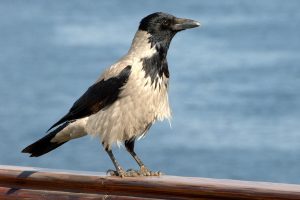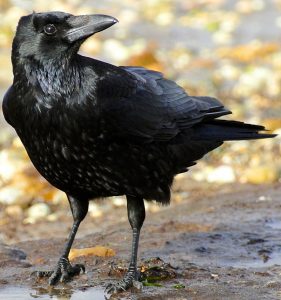12 Evolution
Andrea Bierema
Learning Objectives
Students will be able to:
- Define evolution.
- Describe different mechanisms of evolution, including natural selection, genetic drift, gene flow, and mutation.
- Recognize that new heritable traits result from random mutations.
- Describe sexual selection.
- Identify examples of intrasexual and intersexual selection.
- Use data and physical traits to predict which evolutionary mechanisms and potential selective agents influence a population.
- Distinguish between microevolution and macroevolution.
- Describe possible mechanisms of speciation.
Definition of Evolution
Biological evolution, simply put, is descent with modification.
Biological evolution is not simply a matter of change over time. Lots of things change over time: trees lose their leaves and mountain ranges rise and erode, but they aren’t examples of biological evolution because they don’t involve descent through genetic inheritance.
The central idea of biological evolution is that all life on Earth shares a common ancestor, just as you and your cousins share a common grandmother.
Through the process of descent with modification, the common ancestor of life on Earth gave rise to the fantastic diversity that we see documented in the fossil record and around us today. Evolution means that we’re all distant cousins: humans and oak trees; hummingbirds and whales.
Evolution occurs at different scales:
Mechanisms of Evolution
Although the term “evolution” is often used synonymously with “natural selection,” they are actually referring to different concepts. Evolution is an observable phenomenon in which gene frequencies change over time, but it does not explain why a population is undergoing evolution. This is where natural selection—and other mechanisms—come into play. They explain “the why.”
There are four main mechanisms of evolution:
Exercise
Let’s look at some examples of evolution and see if we can identify which evolutionary mechanism is at play.
Once you complete that, here is another game. This is a matching game using the images from the above quiz. As you match two images, recall which type of mechanism it is and why!
All of these mechanisms can cause changes in the frequencies of genes in populations, so all of them are mechanisms of evolutionary change. However, natural selection and genetic drift cannot operate unless there is genetic variation—that is, unless some individuals are genetically different from others. If the population of beetles was 100% green, selection and drift would not have any effect because their genetic make-up could not change.
Important Notes Regarding Mutations
Mutations are random
Mutations can be beneficial, neutral, or harmful for the organism, but mutations do not “try” to supply what the organism “needs.” In this respect, mutations are random—whether a particular mutation happens or not is unrelated to how useful that mutation would be.
Not all mutations matter to evolution
Because all cells in our body contain DNA, there are lots of places for mutations to occur; however, not all mutations matter for evolution. Mutations that occur in non-reproductive cells won’t be passed onto offspring.
For instance, if a skin cell has a mutation that causes uncontrollable cell division (i.e., cancer), that mutation is not passed to the next generation.
See the “Protein Structure and Function” chapter in this textbook for more information.
Sexual Selection
Darwin noticed that there were many traits and behaviors of organisms that could not just be explained by the ability to survive. For example, the brilliant plumage of peacocks should actually lower their rates of survival. That is, the peacocks’ feathers act like a neon sign to predators, advertising “Easy, delicious dinner here!” But if these bright feathers only lower peacocks’ chances of survival, why do they have them? The same can be said of similar characteristics of other animals, such as the large antlers of male stags or the wattles of roosters, which also seem to be unfavorable to survival. Again, if these traits only make the animals less likely to survive, why did they develop in the first place? And how have these animals continued to survive with these traits over thousands and thousands of years? Darwin’s answer to this conundrum was the theory of sexual selection: the evolution of characteristics, not because of survival advantage, but because of mating advantage.
Exercise
Evolution Examples
Learn more about the mechanisms of evolution via the following examples.
Exercises
Learn more about evolution through this example:
For closed captioning or to view the full transcript see the video on YouTube. Or click on the “YouTube” link in the video.
Optional: To continue learning how predation impacts the natural selection of traits, check out Connected Bio’s simulation on the evolution of fur color in deer mice and PhET‘s simulation (below) on the natural selection of rabbits!
Exercise
Check out Virtual Biology Lab’s Fish Pond simulation. In this simulation, change the migration rate (to test genetic flow), mutation rate, or genotype relative fitness (to test natural selection). You can also change the initial population size.
How does having a small population size affect genotype frequency, by chance (i.e., genetic drift)?
Macroevolution
As explained toward the beginning of this chapter, “macroevolution” refers to the evolution of one or more species. Before examining speciation, let’s first learn about what it means to be a species.
Species Concept
A species is often defined as a group of individuals that actually or potentially interbreed in nature. In this sense, a species is the biggest gene pool possible under natural conditions.
That definition of a species might seem cut and dried, but it is not—in nature, there are lots of places where it is difficult to apply this definition. For example, many bacteria reproduce mainly asexually through binary fission. The definition of a species as a group of interbreeding individuals cannot be easily applied to organisms that reproduce only or mainly asexually.
Also, many plants and some form hybrids in nature. Hooded crows and carrion crows look different and largely mate within their own groups, but in some areas, they hybridize. Should they be considered the same species or separate species?


There are lots of other places where the boundary of a species is blurred. It’s not so surprising that these blurry places exist—after all, the idea of a species is something that we humans invented for our own convenience!
Speciation
Speciation is a lineage-splitting event that produces two or more separate species. Let’s learn about speciation in the birds of paradise in the following interactive video.
For closed captioning or to view the full transcript see the video on YouTube. Or click on the “YouTube” link in the video.
Exercise
Go through additional case studies on evolution, including speciation in Connecting Concepts‘ Natural Selection interactive lesson and Speciation interactive lesson.
Evolutionary Medicine
Understanding evolution helps us solve biological problems that impact our lives. There are excellent examples of this in the field of medicine. To stay one step ahead of pathogenic diseases, researchers must understand the evolutionary patterns of disease-causing organisms. To control hereditary diseases in people, researchers study the evolutionary histories of the disease-causing genes. In these ways, an understanding of evolution can improve the quality of human life.
Read more about the relationships between evolution and medicine in the Evolutionary Medicine chapter from Carl Zimmer’s book, The Tangled Bank.
Attributions
This chapter is a modified derivative of:
Buss, D. M. 2021. Evolutionary theories in psychology. In R. Biswas-Diener & E. Diener (Eds), Noba textbook series: Psychology. Champaign, IL: DEF publishers. <http://noba.to/ymcbwrx4>.
Understanding Evolution. 2020. University of California Museum of Paleontology. 8 August 2020 <http://evolution.berkeley.edu/>.

